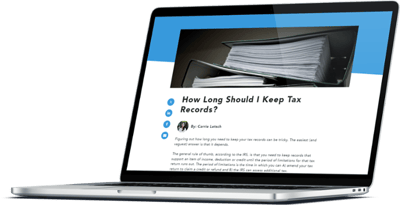Rolling over a company retirement plan distribution into an IRA is usually a good idea. It allows you to defer taxes on the rolled-over balance, and the future income earned on that balance, for as long as the money stays in the IRA. However, the IRA rollover strategy is not always a no-brainer, as one taxpayer discovered in a rollover horror story that could have been prevented with tax-smart advance planning.
But before getting to the taxpayer's story, let's first cover some necessary background information.
The 10% Early Withdrawal Penalty
For purposes of this article, we will call a pre-age 59 1/2 withdrawal from a qualified retirement plan account (such as a company 401(k) account) an early withdrawal. The general federal income tax rule states that the taxable portion of an early withdrawal will get hit with a 10% early withdrawal penalty — unless one of the tax-law exceptions gets you off the hook. The same general rule applies to the taxable portion of an early withdrawal from an IRA (before age 59 1/2).
The Age 55 Exception
For early withdrawals from a company qualified plan, there's an exception to the 10% early withdrawal penalty if you've reached age 55 and have "separated from service" when you take the withdrawal. Separation from service means permanently leaving the company for any reason.
The age-55 exception allows you to take an early withdrawal from the company plan, keep some or all of the money in your pocket instead of rolling it into your IRA, and not owe the 10% early withdrawal penalty on any of the money you choose to keep. Understand that if you do this, you will owe federal income tax (and maybe state income tax, too) on the money, but you won't get hit with the 10% penalty. (However, you won't owe any tax or penalty on any amount that you roll over into an IRA.)
Important: There is no age-55 exception for early IRA withdrawals. That is because the list of qualified retirement plan exceptions to the 10% early withdrawal penalty is not exactly the same as the list of IRA exceptions to the 10% early withdrawal penalty. This may seem to make no sense, but as they say, "it is what it is."
Recent Court Decision Tells Tale of Woe
In a court decision earlier this year, one taxpayer found out the hard way that there is, in fact, no age-55 exception for early IRA withdrawals.
Facts of the case: At the age of 56, Young Kim left his job as a partner in a law firm to attend the London School of Economics. He rolled over the balance from his law firm’s qualified retirement plan account into an IRA. The following year, he withdrew about $240,000 from the IRA and paid the resulting federal income tax liability. However, Kim did not pay the 10% early withdrawal penalty because he believed he qualified for an exception for taxpayers age 55 and older.
The IRS audited Kim's return for the year in which he took the early IRA withdrawal. The tax agency assessed the 10% early withdrawal penalty plus an additional penalty for substantially understating his tax liability by failing to include the 10% penalty on his return. The two penalties totaled more than $24,000.
The taxpayer took his case to the U.S. Tax Court where he argued that it was not logical for the age-55 exception to be allowed for early qualified plan withdrawals but not for early IRA withdrawals. The Tax Court correctly observed that there is no requirement for the tax law to be logical. Therefore, the Tax Court concluded that Kim was indeed liable for the penalties of more than $24,000.
Next, the still-unconvinced taxpayer took his case to the Seventh Circuit Court of Appeals which, unfortunately for him, reached the same conclusion as the Tax Court.
The appeals court reiterated something that most of us have known for years — that the U.S. tax code isn't necessarily rational. The ruling stated:
"Kim insists that this makes no sense. He could have taken the money from the law firm's pension plan without the 10% additional tax; why should it matter that the money went from the law firm's plan to an IRA before being withdrawn? The answer is that the Internal Revenue Code says that it matters...Many parts of the tax code are compromises, and all parts reflect the need for lines that can't be deduced from first principles.
Why can an employee withdraw money from an employer's plan without the 10% addition at age 55 but not age 54? Why does the 10% additional tax apply to withdrawals at age 59 and 181 days, but not 59 and 183 days? These questions cannot be answered by logical analysis. The code's lines are arbitrary."
Tax-smart Advance Planning Could Have Avoided the Problem
Since Kim was older than 55 when he left his law firm job, he would have qualified for the age-55 exception to the 10% early withdrawal penalty if he had simply withdrawn the $240,000 that he needed from the firm's retirement plan.
Then he could have rolled over the rest of his retirement plan money into an IRA with no taxes due on the rolled-over amount. Instead, he rolled all the retirement plan money into the IRA and then took the $240,000 from the IRA. Because the IRA withdrawal occurred while he was under age 59 1/2, the 10% early withdrawal penalty applied.
The moral of the story: While rolling all of your company retirement plan money into an IRA is generally a good idea, it is not always the most tax-smart step to take. (Young Kim, 7th Circuit Court of Appeals, 2012, No. 11-3390)
How You Can Avoid a Similar Fate
What happened in Kim's case illustrates why you should consider seeking professional tax advice whenever you are contemplating a significant financial move. The IRA rollover rules seem simple (see information below for the basics), but many taxpayers fall into traps when leaving their jobs. With proper advance planning, it is often possible to achieve your objectives in a way that minimizes taxes. Without proper planning, the tax results may be dire, and you may not be able to improve those results after the fact.
Consult with your tax advisor if you have questions or want assistance to ensure a smooth, tax-free transaction.
Basic IRA Rollover Rules
After retiring or leaving a job, one big question might be: What should you do with the money in qualified retirement plan accounts with your former employer? These accounts include 401(k)s, profit-sharing plans, and stock bonus plans. The standard advice is to roll everything over into an IRA. That advice generally makes sense because you can take over management of the funds while continuing to defer taxes on income generated. However, as the court case described in this article illustrates, the standard advice isn't best in all situations.
Arrange For a "Direct" Rollover
If you decide to go this route, arrange for a "direct" or "trustee-to-trustee" rollover from the qualified retirement plan into your IRA. In other words, the check from the company plan should be made out to the trustee or custodian of your rollover IRA. You may be able to arrange for a wire transfer directly into the rollover IRA.
Key point: While the IRA must be set up in advance to receive the upcoming rollover contribution, the account can be empty prior to the transaction.
Why is a direct rollover important? If you receive a retirement plan distribution check payable to you personally, 20% of the taxable amount of the distribution must be withheld for federal income taxes. You are left with a check for only 80% to deposit into the account, although you are responsible for depositing 100%.
You have 60 days to come up with the other 20% and deposit it into the IRA. Otherwise, you will owe income tax on that 20%, plus a 10% early withdrawal penalty tax generally applies if you are under age 55 when leaving your job.
Of course, if you fail to deposit the 20%, you will still be entitled to a federal income tax refund because the withholding will exceed the actual tax (and 10% penalty if applicable) that you owe. However, you won't get that refund until after filing a tax return for the year the withholding occurs. That could be many months later. Even worse, your rollover IRA balance will be 20% smaller, which means lost tax deferral benefits.
Note: The mandatory 20% federal income tax withholding rule doesn't apply if you are rolling money from one IRA to another. It only applies to distributions from a qualified retirement plan, such as a 401(k) plan. However, you must always meet the 60-day rule, even for an IRA-to-IRA rollover.
Obey the 60-day Rule
Another pitfall is failing to meet the 60-day rule. Specifically, you must deposit the retirement account distribution into an IRA within 60 days to achieve a tax-free rollover. The 60-day period starts on the day after the funds are received from the retirement plan and ends on the day you deposit them into an IRA.
Note: Unlike many IRS deadlines, you don't get extra time if the end of the 60-day period occurs on a weekend or holiday.
In fact, the only instance when failing to meet the 60-day rule isn't disastrous to your tax planning objectives is if the failure is due to "circumstances beyond your control." Even in these cases, you have to prove to the IRS that you are blameless.
Need Help?
Contact us online or call 800.899.4623.


